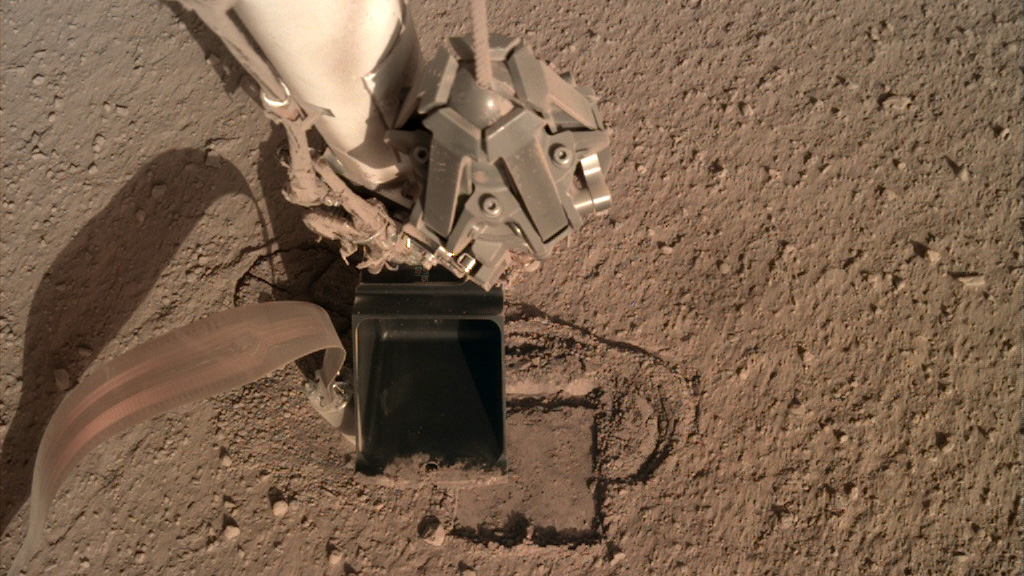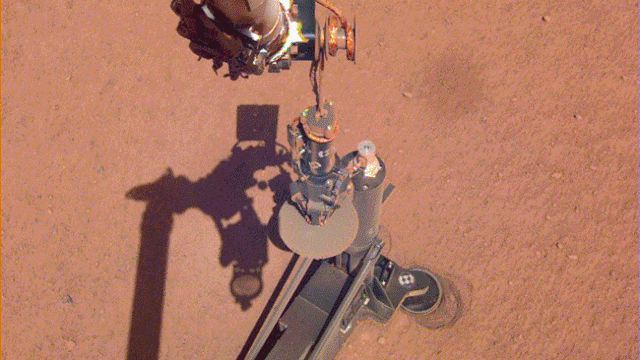NASA’s Stuck Mars 'Mole' Gets a Helping Hand from Arm Scoop
An instrument on NASA's InSight lander has been stuck in the Martian soil for months, but engineers have come up with a new plan to try to save the device.
The InSight lander's self-hammering heat probe, also known as "the mole," has been stuck in place since Feb. 28. It was supposed to burrow 16 feet (5 meters) into the ground, but it stalled way short, at 14 inches (35 centimeters).
To be fair to the mole, it's digging into unknown territory. Nothing has ever dug that deep in Martian soil before, so it's hard to predict what the regolith is made of. NASA and the German space agency, which made the mole and the Heat Flow and Physical Properties Package (HP3) of which it is a part, have been working together since June on alternative fixes.
Related: Mars InSight in Photos: NASA's Mission to Probe Core of the Red Planet

Their latest idea is to push the mole against the wall of the hole it created, using another instrument: InSight's scoop, which is located on a robotic arm. Since the mole is slipping in the hole as it tries to dig further, forcing the instrument against the wall just might work, officials said. "This might increase friction enough to keep it [the mole] moving forward when mole hammering resumes," Sue Smrekar, InSight deputy principal investigator at NASA's Jet Propulsion Laboratory, said in a statement.
The mole is intended to measure heat flow from the interior of Mars, which will help answer questions about whether there is volcanic activity on the planet and how similar the geologic histories of Earth and Mars are. This is all central to NASA's ongoing search for life on Mars, since life as we know it, on planet Earth, formed on an active world, with volcanoes and plate tectonics. It's unclear how geologically active Mars is, and scientists are still learning a lot about processes such as possible "marsquakes" and volcanic activity.
The mole is supposed to dig autonomously, and it isn't supposed to be removed from its hole once it starts to dig. A few months ago, engineers instead tried removing a support structure that is supposed to hold the mole in place. They did this to better examine the hole and the area in which the mole was slipping. Pictures sent back from Mars showed that the mole is burrowing into "duricrust," a sort of cemented soil. No other Mars mission has ever encountered this kind of soil, and thus, the mole wasn't designed for it.
Get the Space.com Newsletter
Breaking space news, the latest updates on rocket launches, skywatching events and more!

The team spent months using the arm scoop to try to collapse the hole, but the arm is being used at an angle that nobody anticipated during mission testing. The scoop was originally intended to serve as a landscaping tool that would be used only in the event that InSight didn't have a clear, flat spot to deploy its instruments. The HP3 instrument is placed very far away from the lander so that the spacecraft's shadow won't mess with the temperature readings the heat probe is supposed to gather from underground. The position of HP3 means the arm must stretch far out and press its scoop down on an angle to reach the hole, which doesn't provide much force to collapse the regolith.
"We're asking the arm to punch above its weight," Ashitey Trebi-Ollennu, the lead arm engineer at NASA's Jet Propulsion Laboratory (JPL) in Pasadena, California, said in the same statement. "The arm can't push the soil the way a person can. This would be easier if it could, but that's just not the arm we have."
Alternatively, the scoop could be used to bring more soil into the hole so the mole could regain traction that way. NASA will continue to monitor the mole's progress and take pictures of its work. Both techniques to rescue the instrument, the scooping and the pressing, might be visible in raw images beamed onto this website in the coming weeks.
While the rescue operation is forcing engineers to think outside their original design, this kind of thinking isn't new territory for JPL on Mars, the center pointed out. For example, engineers helped the Opportunity rover out of a sand trap in 2005, and more recently, they successfully used alternative drilling techniques with a wonky drill on the long-running Curiosity rover mission.
- InSight Team Gets Look at Stuck 'Mole' on Mars
- NASA's Mars InSight Lander: 10 Surprising Facts
- Measuring Marsquakes: How NASA's InSight Lander Will Peer Inside Red Planet
Follow Elizabeth Howell on Twitter @howellspace. Follow us on Twitter @Spacedotcom and on Facebook.

Join our Space Forums to keep talking space on the latest missions, night sky and more! And if you have a news tip, correction or comment, let us know at: community@space.com.

Elizabeth Howell (she/her), Ph.D., was a staff writer in the spaceflight channel between 2022 and 2024 specializing in Canadian space news. She was contributing writer for Space.com for 10 years from 2012 to 2024. Elizabeth's reporting includes multiple exclusives with the White House, leading world coverage about a lost-and-found space tomato on the International Space Station, witnessing five human spaceflight launches on two continents, flying parabolic, working inside a spacesuit, and participating in a simulated Mars mission. Her latest book, "Why Am I Taller?" (ECW Press, 2022) is co-written with astronaut Dave Williams.









